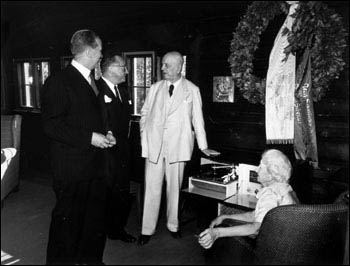The nursery of Ainola was converted into a library in 1935, when the last of the daughters had married and moved away. The repairs and redecoration were planned by the husband of Sibelius's youngest daughter Heidi, the architect Aulis Blomstedt (see also The renovation of the dwelling house and the construction of the extension 1911-1935).
When you enter the library from the dining room, you see the corner on the left where Sibelius smoked his cigars. It was here that the aged composer listened to his compositions on the radio and on records.


On the right is Sibelius's armchair, which was brought from Kammiokatu in the 1940s. Beside the chair is a cabinet containing a record player, a gift from the electricity company Pohjoismaiden Sähkö Oy. There is also a radio-gramophone, presented to the composer by the Philips company at the start of the 1950s.
At first Sibelius refused to listen to music on the radio, as the sound quality was so poor, but he changed his mind in the 1930s. "Radio and records spread musical knowledge on a scale previously undreamt of, thus raising the general level," the composer said to his secretary in the 1940s.

Jean Sibelius receiving the Philips radio-gramophone at Ainola in 1951.
Further back in the room is a smoker's table covered with crystal glass. There are also armchairs manufactured by N. Boman Oy. The other armchairs and small tables in the library are from the apartment in Kammiokatu.

On the stove to the left is a plaster figure of Sibelius's youngest daughter Heidi, modelled by the sculptor G. Nyholm.

The rest of the left wall is covered by an enormous expanse of shelving, where the Sibeliuses finally managed to place most of their books.

> The books of Ainola
> Art in the library at Ainola

![]()
![]()
